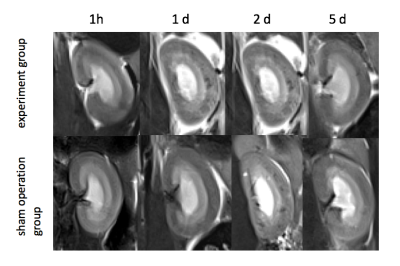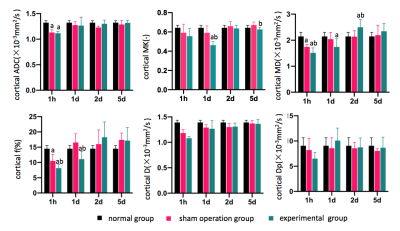Lihua Chen1, Yan Ren1, Yizhong Yuan2, Jipan Xu2, Jinxia Zhu3, Xuening Zhang4, Robert Grimm5, and Wen Shen1
1Tianjin First Center Hospital, Tianjin, China, 2First Central Hospital Institute, Tianjin Medical University, Tianjin, China, 3Siemens Healthcare Ltd., Beijing, China, 4Second Hospital of Tianjin Medical University, Tianjin, China, 5Siemens Healthcare GmbH, Erlangen, Germany
1Tianjin First Center Hospital, Tianjin, China, 2First Central Hospital Institute, Tianjin Medical University, Tianjin, China, 3Siemens Healthcare Ltd., Beijing, China, 4Second Hospital of Tianjin Medical University, Tianjin, China, 5Siemens Healthcare GmbH, Erlangen, Germany
The bi-exponential
and kurtosis models based on multi-b-value DWI can quantitatively and
noninvasively detect pathophysiologic
renal changes and evaluate
molecular water diffusion, microcirculation perfusion, and microstructural changes.

T2-weighted imaging (T2WI) images of the experimental
(upper panel) and sham (lower panel) operation groups at 1 hour, 1 day, 2 day,
and 5 day (left to right) after the operations to induce renal cold
ischemia-reperfusion injury (CIRI).

Column graphs show renal cortical parameter comparisons
among the three groups at 1 hour, 1 day, 2 day, 5 day after surgery. a
and b show statistical differences compared with the normal and sham
operation groups, respectively (P < 0.05). The apparent
diffusion coefficient (ADC), mean diffusivity (MD), real diffusion coefficient
(D), and false diffusion coefficient (DP) values are displayed as
×10-3mm2/s, and f values as %. The mean kurtosis (MK)
parameter has no unit.